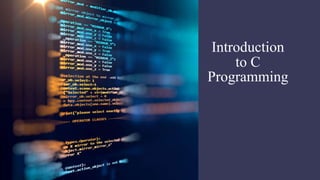The document provides a comprehensive overview of the C programming language, including its history, characteristics, and structure. It discusses essential concepts such as data types, variables, constants, and input/output functions, while also explaining the components of a C program and its file structure. Additionally, it highlights the significance of C in system programming and application development.








































































![gets()
String I/O
This function is used for accepting any
string( stream of characters) until enter
key is pressed
Syntax
char str[length of string in number];
gets(str);
Example:
char name[15];
gets(name);
Program
#include<stdio.h>
void main()
{
char ch[30];
printf(“Enter the string:”);
gets(ch);
printf(“Entered string: %s”, ch);
}
Output:
Enter the string: Use of data!
Entered string: Use of data!](https://image.slidesharecdn.com/cprointroduction-230121164754-72b1ccd6/85/c_pro_introduction-pptx-73-320.jpg)
![puts()
This function prints the string or
character array.
It is opposite to gets()
Syntax
char str[length of string in number];
gets(str);
puts(str);](https://image.slidesharecdn.com/cprointroduction-230121164754-72b1ccd6/85/c_pro_introduction-pptx-74-320.jpg)